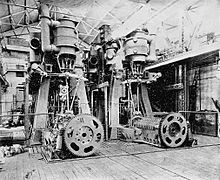
USS Oregon (BB-3) was the third and final member of the Indiana class of pre-dreadnought battleships built for the United States Navy in the 1890s. The three ships were built as part of a modernization program aimed at strengthening the American fleet to prepare for a possible conflict with a European navy. Designed for short-range operations in defense of the United States, the three Indiana-class ships had a low freeboard and carried a main battery of four 13-inch (330 mm) guns in a pair of gun turrets. Oregon and her sister ships were the first modern battleships built for the United States, though they suffered from significant stability and seakeeping problems owing to their small size and insufficient freeboard.

USS Iowa was a pre-dreadnought battleship built for the United States Navy in the mid-1890s. The ship was a marked improvement over the previous Indiana-class battleships, correcting many of the defects in the design of those vessels. Among the most important improvements were significantly better seaworthiness owing to her greater freeboard and a more efficient arrangement of the armament. Iowa was designed to operate on the high seas, which had been the impetus to increase the freeboard. She was armed with a battery of four 12-inch (305 mm) guns in two twin-gun turrets, supported by a secondary battery of eight 8-inch (203 mm) guns.

USS Massachusetts was an Indiana-class, pre-dreadnought battleship and the second United States Navy ship comparable to foreign battleships of its time. Authorized in 1890, and commissioned six years later, she was a small battleship, though with heavy armor and ordnance. The ship class also pioneered the use of an intermediate battery. She was designed for coastal defense and as a result, her decks were not safe from high waves on the open ocean.

The Battle of Santiago de Cuba was a decisive naval engagement that occurred on July 3, 1898 between an American fleet, led by William T. Sampson and Winfield Scott Schley, against a Spanish fleet led by Pascual Cervera y Topete, which occurred during the Spanish–American War. The significantly more powerful US Navy squadron, consisting of four battleships and two armored cruisers, decisively defeated an outgunned squadron of the Royal Spanish Navy, consisting of four armored cruisers and two destroyers. All of the Spanish ships were sunk for no American loss. The crushing defeat sealed the American victory in the Cuban theater of the war, ensuring the independence of Cuba from Spanish rule.
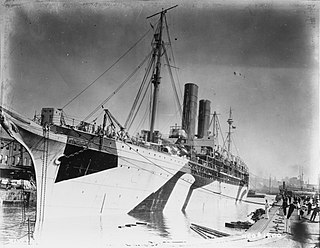
The first USS Harvard of the United States Navy was an auxiliary cruiser in the Spanish–American War. She was launched as City of New York, and later commissioned as Plattsburg (SP-1645) for service in World War I.

SS Saint Paul was a trans-Atlantic ocean liner named for the capital of Minnesota.

USS Yankee was originally El Norte, a steamer launched 14 June 1892 and delivered 15 August 1892 at Newport News, Virginia, by the Newport News Shipbuilding & Drydock Co. for the Southern Pacific Railroad's Morgan Line. The ship was acquired by the United States Navy from the Southern Pacific Company on 6 April 1898. The ship was renamed and commissioned at New York on 14 April 1898, Commander Willard H. Brownson in command.
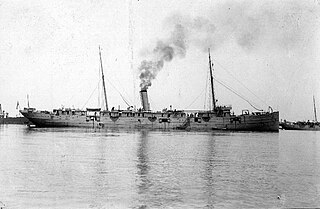
The first USS Yosemite was an auxiliary cruiser of the United States Navy. Built as El Sud in 1892 by Newport News Shipbuilding and Dry Dock Company, in Newport News, Virginia for the Southern Pacific Railroad's Morgan Line. The Navy acquired El Sud on 6 April 1898, at the beginning of the Spanish–American War and renamed her Yosemite. It commissioned her on 13 April 1898 under Commander William H. Emory.

City of New York was a British built passenger liner that was designed to be the largest and fastest liner on the Atlantic. When she entered service with the Inman Line in August 1888, she was the first twin screw express liner in the world, and while she did not achieve the westbound Blue Riband, she ultimately held the eastbound record from August 1892 to May 1893 at a speed of 20.11 knots. City of New York and her sister City of Paris are considered especially beautiful ships, and throughout their careers were rivals to White Star Line's Teutonic and Majestic. In February 1893, the Inman Line was merged into the American Line and, by act of Congress, the renamed New York was transferred to the US flag. Beginning in the mid-1890s, New York and Paris were paired with St Louis and St Paul to form one of the premier Atlantic services. New York continued with the American Line until 1920 and was broken for scrap in 1923. She served in the United States Navy as USS Harvard during the Spanish–American War, and Plattsburg in World War I. She is also remembered for nearly colliding with RMS Titanic as the latter ship departed on her maiden voyage in 1912.
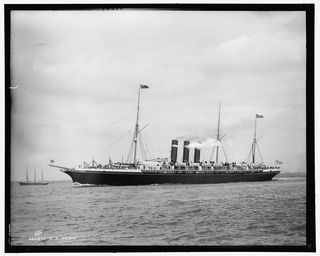
City of Paris, was a British-built passenger liner of the Inman Line that held the Blue Riband as the fastest ship on the north Atlantic route from 1889 to 1891 and again from 1892 to 1893. A sister ship of the City of New York and a rival of the White Star Line Teutonic and Majestic, she proved to be the quickest of the pre-Campania twin-screw express liners. In 1893, she was renamed Paris and transferred to US registry when the Inman Line was merged into the American Line. She and her sister were paired with the new American built St Louis and St Paul to form one of the premier Atlantic services. Paris served the US Navy as the auxiliary cruiser USS Yale during the Spanish–American War and is remembered for slipping into the harbor at San Juan, Puerto Rico, under the Spanish guns of Morro Castle. After Paris returned to commercial service, she was seriously damaged in 1899 when she grounded on The Manacles off the British coast. Rebuilt and renamed Philadelphia, she sailed for the American Line until requisitioned again during World War I as the transport Harrisburg. After the war, she continued with the American Line until 1920 and was scrapped in 1923.

The second USS Suwannee and third USS Mayflower was a United States Lighthouse Board, and later United States Lighthouse Service, lighthouse tender transferred to the United States Navy in 1898 for service as an auxiliary cruiser during the Spanish–American War and from 1917 to 1919 for service as a patrol vessel during World War I. She also served the Lighthouse Board and in the Lighthouse Service as USLHT Mayflower from 1897 to 1898, from 1898 to 1917, and from 1919 to 1939, and in the United States Coast Guard as the first USCGC Mayflower (WAGL-236) in 1939 and from 1940 to 1943 and as USCGC Hydrangea (WAGL-236) from 1943 to 1945.

Reina Mercedes, was an Alfonso XII-class unprotected cruiser of the Spanish Navy.
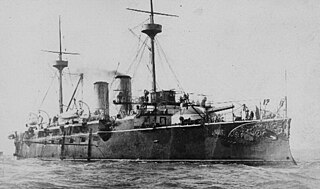
Vizcaya was an Infanta Maria Teresa-class armored cruiser of the Spanish Navy that fought at the Battle of Santiago de Cuba during the Spanish–American War.

Almirante Oquendo, was an Infanta Maria Teresa-class armored cruiser of the Spanish Navy that fought at the Battle of Santiago de Cuba during the Spanish–American War.

Infanta María Teresa was the lead ship of her class of armoured cruiser constructed for the Spanish Navy. The ship fought at the Battle of Santiago de Cuba during the Spanish–American War.
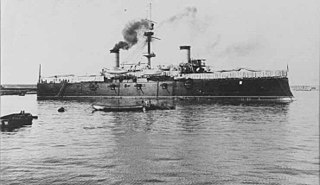
Cristóbal Colón was a Giuseppe Garibaldi-class armored cruiser of the Spanish Navy that fought at the Battle of Santiago de Cuba during the Spanish–American War.
Plutón was a Furor-class destroyer of the Spanish Navy that fought at the Battle of Santiago de Cuba during the Spanish–American War.

Furor was a Furor-class destroyer of the Spanish Navy that fought at the Battle of Santiago de Cuba during the Spanish–American War.

The Flying Squadron was a United States Navy force that operated in the Atlantic Ocean, the Gulf of Mexico and the Spanish West Indies during the first half of the Spanish–American War. The squadron included many of America's most modern warships which engaged the Spanish in a blockade of Cuba.

USS Wompatuck (YT-27) was an armed tug in commission in the United States Navy from 1898 to 1931. Early in her naval career, she saw combat in the Spanish–American War and the Philippine–American War. After she was decommissioned, she was selected for conversion into the fuel oil barge YO-64, but she was lost in the early days of World War II in the Pacific before the conversion could be completed.

